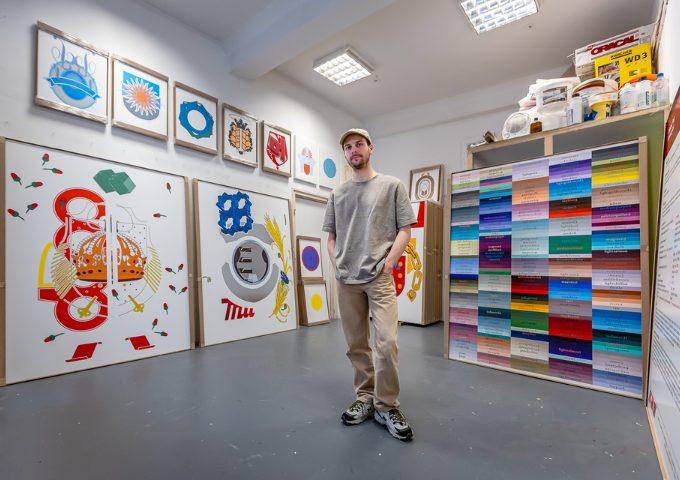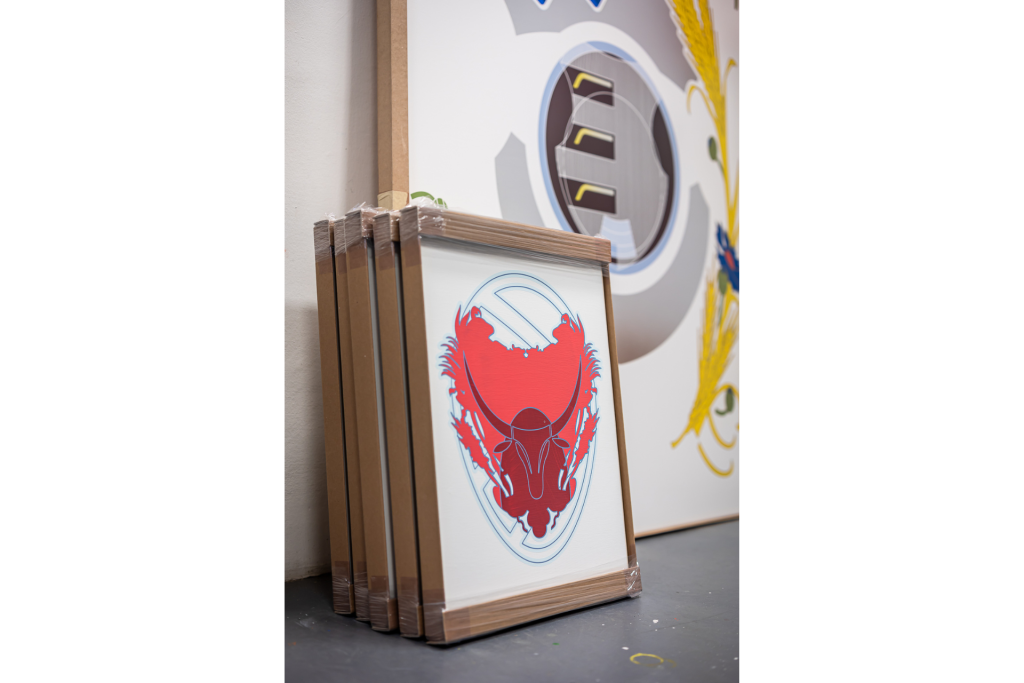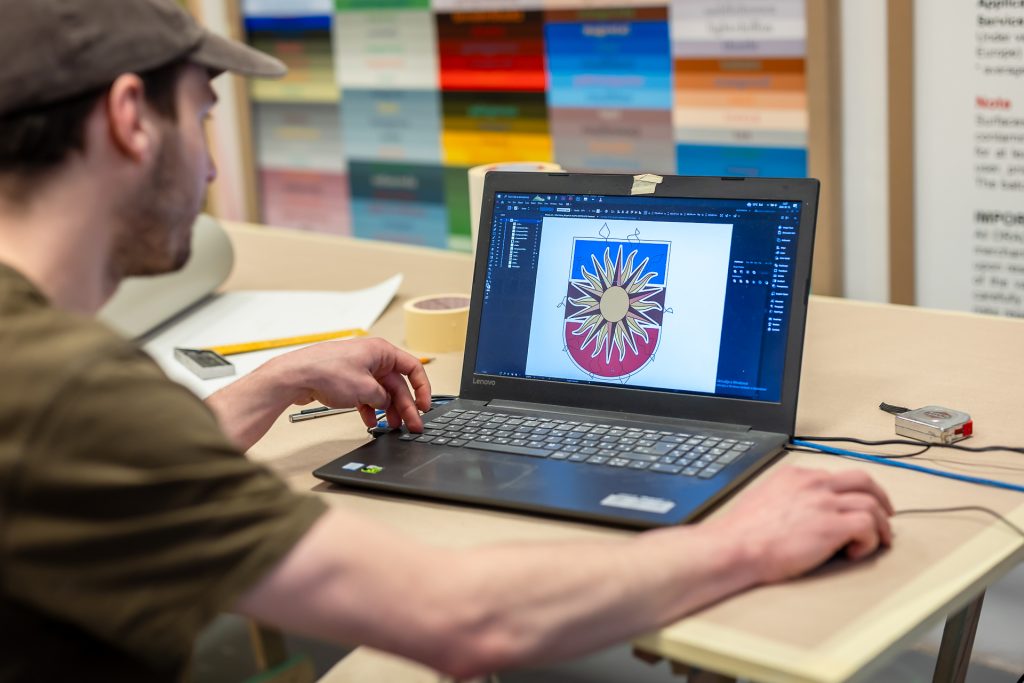Ádám Varga is one of the youngest artists to appear in the collection of the Central Bank of Hungary (Magyar Nemzeti Bank, MNB), but he has already caught the attention of the profession. He has won the Derkovits Prize, participated in numerous exhibitions, and is also active as an art organizer. He operates an independent artist-run space with his colleagues: the PINCE exhibition space in Budapest. He currently works in a studio house in the 11th district, also with several other artists.
Do you keep track of who else works in the house? Do you keep an eye on each other, do you stick together?
It has always been very important for me to see more than just my own work, because through the work of others I learn a lot about things that are outside my interests. Artists mainly come to the studios to work, which is why there is a smaller flow of people characterizing the atmosphere here. Previously, at the University of Fine Arts, I knew mostly the artists on the same platform as me and those in senior classes before me, but I tried to get a broader perspective. Today I am more open.
In a peculiar situation, you graduated just before Covid, but that didn’t stop you from starting out. Is that how you see it from the inside as well?
I graduated in 2019 and went to Leipzig for six months with Erasmus at the Galerie für Zeitgenössische Kunst. I came home in January and by March Covid had hit. I was just about to start making art with the fresh enthusiasm of anyone leaving university when the stop sign went up. The studio in the Dürer Garden closed down, and during the quarantine I worked at home for a year. It was during that period that I acquired my foil cutting machine, which I still use today, and many important layers of content and directions became clear to me then. I had time to experiment with the machine, to do different tests. During this period, I focused on the anomalies and problems that could be observed when using the machine, which eventually resulted in a project lasting two to three years, with different solutions and work split up along different concepts.
So, you actually started your career with a big introspection. What is it like to work alone?
This is only half true. Since the beginning of university, I have been a member of PINCE Artist-run space, which provides exhibition opportunities for young emerging artists. It really is a small basement space that requires a completely different attitude – it’s more about giving opportunities to others than it is about independent practice. So, of course, I turned inward, but on the other hand, the PINCE kept me in the middle of the environs, running the art scene. If it hadn’t been for this as an entity, it would have been a much worse beginning. During this period, the circumstances of Covid made everyone take stock of what they had and start to nurture and redefine it. Life hasn’t stopped, for example, we renovated the PINCE and even managed to get funding for it. In addition, I tried to focus on work at home, hoping that the situation would somehow revive.
How did you become an artist?
From the age of eight I danced competitively, Latin dances. I loved it, but at the age of 14 I started to go to art school at the same time, and after a few years it was time to make a decision. I could not practice the two activities with equal intensity and I chose the University of Fine Arts. In a way, I saw fine art as a more intellectual path, and I increasingly see it as my vocation.
Different artists all with different approaches. What were you looking for in art?
It’s always important to have a sense of purpose and purposefulness, for me to be able to see a situation in its own quality, to understand it. Once I had made my decision clear, I wanted to dig deeper and focus less on the pathos in art. I was more interested in its conceptuality: what is it, how is it constructed, what are the artistic roles, what is the historicity of the concept, what phenomena can be detected, are there problems, anomalies, what are the paradoxes – and what can I do with all this? So, a lot of situations and questions have come up in my mind, and asking questions continues to be a more exciting process for me than finding myself in art.
What you’re saying seems to be a fresh approach, at least compared to the more prophetic artistic role conceptions of earlier times. At the university, was it an occurring question, what an artist is like? How does a practising artist develop, what does he think his role and job is?
Nobody knows, and it is difficult to answer too. There is a lot of criticism of the University of Fine Arts for its lack of structure, which some people can exploit and others get lost in. I also went there to be taught who the artist was and what art was, and then the first big realisation was that it’s not a ready-made system, it’s not a table to be memorised. In fact, perhaps the most important thing is, what the response may be to this fluid situation.
Anyway, you can’t complain about your start, you got noticed quickly and the MNB bought some of your work too. What do you think prompted this? Can the CMYK series be interpreted as a search for a place for art in the digital world?
Around graduation, my overall project was to compare the whole attitude of painting with the digital problems of copying, replicability and reproducibility. Part of posing these questions was the 2019 CMYK series, which was added to the MNB collection. The series consists of fifteen canvases, each composed of eight homogeneously painted bars of colour, and it is actually a painterly reinterpretation of the colour coding used in the printing industry. Between graphics software and digital printing, I used the four-colour printing (CMYK) code system to ensure precisely calibrated colour accuracy. I mixed up the machine tones of cyan, magenta, yellow and black layers and hand-painted them on the canvas, making me a quasi-painting machine, while the images are unique.
Reproductions in art publications are a reference example of how these images actually have accurate colours. In essence, I was trying to turn this question around. It was not the painting I considered as primary and the reproduction as secondary, but vice versa. I tried to copy the digital image as a printer, using my own technical skills. For me, the point crystallized at the end of the process: we should compare these paintings with the reproductions in terms of the extent to which I was instrumentalizing my own art by painting them; where is the intuition, and where lies the role of painting. What situation occurs when I compare the different technical processes, the notion of digitality with the manual nature of painting, and individual practice with a mechanical, instrumental attitude? As for me, I argued in favour of instrumental.
What’s your opinion on artificial intelligence? What if the machine makes the picture?
This is a particularly difficult question. I think artificial intelligence in many cases is really performance maximisation. To make social practices work as quickly, as naturally, as networked and as productively as possible. Artificial intelligence helps to do that, and in that sense it’s a one-dimensional thing for me. It aims to make production itself, and social practices, operate more fluidly, at a much higher speed. Although I consider it to be a very important and indispensable factor, I would not define myself in opposition to it, not as if the dry neutrality of artificial intelligence should be counterpointed by my art. Rather stating what my works say in relation to this relationship, and to what extent the role, possibilities and authenticity of painting are problematic and mechanical in comparison.
Why is it so important for you to be purposeful, problem-focused and performance-oriented?
In general, I find that it is through these concepts that I see sense in framing my work, because they frame production in general. This is the paradigm itself. This is how we were raised artistically, and perhaps that is why it is important for me to unpack this and understand the phenomena and conceptual qualities behind the production. When seemingly different things, works or series are juxtaposed, say over a five-year period, I look at where I come from, where I arrive at and where the pattern is in the structure. Where you can seize kind of an external position. For example, I have a series of a hundred etchings, which are apparently monochrome surfaces, and only up close, in a sort of refraction, does it become clear that each painting shows the same cogwheel. On the one hand, the whole series can be seen as a kind of identicality, a unity. On the other hand, the aim was to highlight the subtle difference in this identicality. I tried to capture the inner workings of production, how objects that look different are somehow often the same, or to put it another way, reflect the same authentic quality. So, I gave a possible painterly answer to the question of what production is.
What do you think is the role of painting at the moment and where is it heading?
I think what we consider painting is mostly a question of definition. A painting is narrowly defined as a view painted on canvas, but painting is a different, much broader and much more flexible concept. There are a lot of practices that go beyond the category of painting, yet we call it painting. If artists arrange things in their environment in the way a painter would arrange different relations in a painting, they are then creating with a painterly attitude. From this perspective, I am a more classical painter, for me it is important to have the canvas, to do it myself, but it is also important that each work is about a set of rules, a set of problems focusing on the situation and the nature of painting.
Your latest works look like coats of arms. What are they?
For the last five or six years, I have been more deeply interested in thinking in terms of series, the use of production as a tool, and the painterly possibilities of reproduction and reproducibility. Lately, however, I have started to feel that the very rules I have set up are locking me in a vise and starting to act as a barrier to the creative process. I feel that I have built up an absolute, totalitarian system and I need to take a step back to conceptualise future work through different terms. I would like to focus less on what can be grasped instrumentally, and instead aim to embed a more flexible, broader framework, of which this project of fictitious coats of arms is the first step, so to speak. On the one hand, I try to incorporate the conceptual dimensions and technical solutions into this series that have formed in me so far. On the other hand, I’m trying to go beyond the way I’ve been working and focus on the multi-directionality of meanings and relations. It’s an open situation for me as well, but the work that has been done so far gives me a better idea of the direction this project should take.












